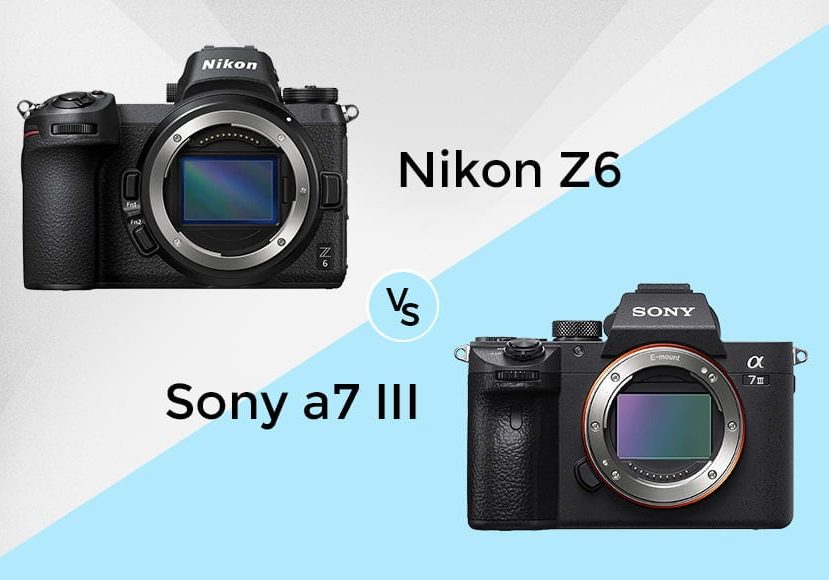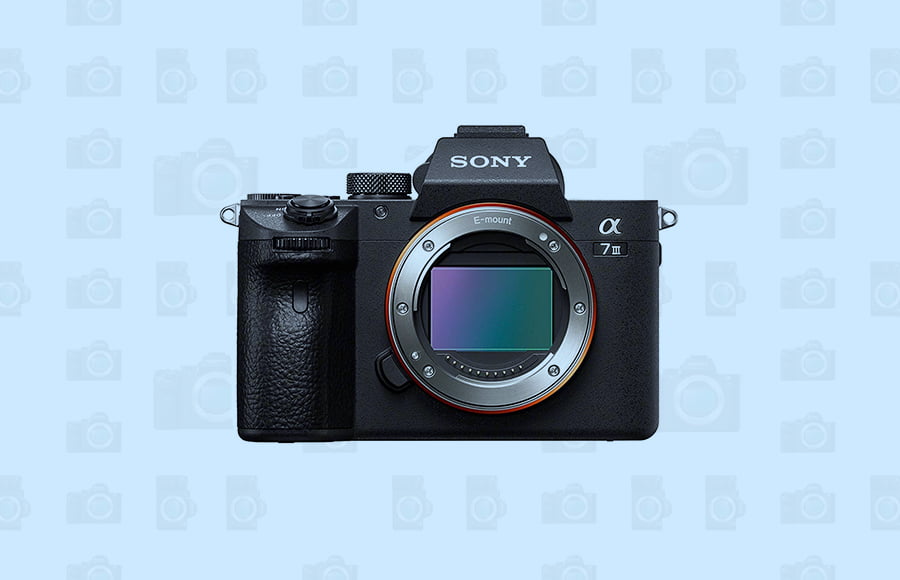
Nikon Z6 vs Sony a7 III – What’s the big difference?
Which of these two popular mirrorless cameras is better? Find out in this in-depth guide as we compare the pros & cons and look and which one to buy.
If you’re struggling to decide between the Nikon Z6 vs Sony a7 III, then this guide will give you all the information you need to make a decision.
On the one hand, you have the Sony a7 III, praised by most critics as one of the best full-frame mirrorless cameras on the market.
It comes from a long lineup of standout performers and offers a well-rounded set of features that’ll keep both still shooters and videographers satisfied.

This powerhouse of a camera wins us over with its incredible image quality and impressive features, all for a competitive price..
And on the other, you have the Nikon Z6. It’s the (slightly) newer model and it’s generally well-regarded, but it comes as one of Nikon’s first and only attempts at a full-frame mirrorless body.
So which of the two cameras is better for your photography needs?
Read on to find out.
(Related: Read our comparison of Sony a7R II vs Sony a7 III and the full Nikon Z6 review.)
Sony a7 iii vs Nikon Z6 | Key Differences
1. Size & Weight
Both the Nikon Z6 and Sony a7 III are full-frame mirrorless cameras, and it shows. While neither body is as big or as heavy as comparable full-frame DSLRs, you still get two relatively hefty cameras.
The Nikon Z6 is technically heavier, at 675 g (1.5 lbs), but the Sony a7 III is hot on its heels (650 g/1.4 lbs), and the difference is small enough that you probably won’t notice when in the field.
This weight difference comes, at least in part, from differences in size:
The Z6 clocks in at 134 x 100.5 x 67.5mm, compared to the 126.9 x 95.6 x 73.7 dimensions in the a7 III.
In practice, this translates to a slightly larger front grip on the Nikon Z6. For photographers used to DSLR-style bodies, the Z6 will feel a bit more comfortable, though you’re also going to lose one of the primary advantages of a mirrorless body (size). On this side of the Nikon Z6 vs Sony a7III, there is one winner.
2. Rear LCD & EVF
One of the areas where Sony has consistently lagged behind is with respect to EVFs – and the Sony a7 III is a prime example of this.
The a7 III features a 2360K dot OLED EVF with 0.78x magnification, and while this is perfectly respectable for an APS-C camera or a low-end full-frame body, it’s just not that great for a professional body.
Compare this to the Nikon Z6, which offers a 3690K dot OLED EVF with 0.8x magnification, on par with the Canon EOS R and even the Fujifilm X-T3.
Viewfinder specs like this ensure a bright, crisp image, which is especially important for photographers switching over from DSLRs (as many Sony a7 III shooters will be).
Neither camera will offer an image quite as sharp as an optical viewfinder, but the Nikon Z6 does come closer.
As for the rear LCD screen:
Both are tilting, both are touchscreens, but again, the Nikon Z6 has the edge.
You get a slightly bigger screen (3.2”/8 cm on the Z6, versus 3”/7.6 cm on the a7 III), as well as more than double the resolution (2.10 M dots on the LCD screen of the Z6, compared to 0.9 M dots on the a7 III).
Depending on your shooting style and the type of work you do, this may be irrelevant – or it may be a make-or-break feature.
So ask yourself: Do you need a large, high-res LCD screen?
If so, the Nikon Z6 may be the way to go.
3. Image Quality
If you’re looking for top-notch image quality, then either one of these cameras is going to be a great buy.
You get a 24.2 MP BSI (back-side illuminated) sensor on the Sony a7 III, compared to a 24.5 BSI sensor on the Nikon Z6. In practice, this means that both cameras feature essentially identical resolutions, as well as excellent low-light capabilities – perfect for any type of indoor shooting or morning/evening photoshoots.
Note that the ISO specs on both cameras are the same: a 100-51200 ISO range, with the option to boost ISO to 204800 on the high end and 50 on the low end. You get a bit of noise creeping in on both cameras as you approach ISO 12800, with photos becoming noticeably noisy by ISO 25600.
Also note that while the resolution here isn’t quite as high as competitors, including Nikon’s own Z7, Sony’s own a7R III (and a7R IV), and even the Canon EOS R/RP pair, most photographers don’t need more than 20+ megapixels.
In fact, most serious photographers who gravitate toward the megapixel monsters I mentioned above are going to be landscape or commercial shooters, where detail and enlargement quality is prized above all else.
Plus, lower megapixel count contributes to better high-ISO capabilities on average. This is part of the reason why you’re going to see better ISO performance on these two cameras compared to, say, the 30 MP EOS R.
As for dynamic range, both the a7 IIIand the Z6 are neck and neck, while offering a very respectable performance.
All in all: These models both feature spectacular image quality, even if their resolutions aren’t class-leading.
4. Ergonomics and Extra Features
When it comes to ergonomics and features, both of these cameras do well – but each struggle in a key area.
On the Nikon Z6, there’s a lot to like. As I mentioned above, the front grip is noticeably bigger and fits the DSLR mould.
You also get better menu organization – because while the a7 III features Sony’s more recent menu iteration, it just doesn’t hold up compared to the Z6’s well-implemented, easy-to-use system.
Both of these two cameras also offer a tilting screen with touch capabilities, though Nikon offers a bit more in terms of touch options (for photographers who want to embrace touch functionality more fully).
You also get silent shooting on both cameras, which is a huge benefit for anyone who works in quieter environments (e.g., event photographers) or who needs to do some stealthy shooting (street photographers).
There is one place that the Nikon Z6 falls down compared to the Sony a7 III:
Card slots.
For some unclear reason, the Z6 only includes a single memory card slot – and it takes XQD cards. While these are faster and a bit more durable than standard SD cards, they’re also more expensive.
Plus, most photographers looking at both of these cameras are going to already possess quite a few SD cards, so making the switch to XQD is going to be supremely frustrating.
The a7 III, on the other hand, offers two memory card slots, both SD (though only one supports the faster UHS-II cards).
And if you’re a photographer who requires redundancy in your work (e.g., wedding, sports, photojournalist), this alone could be the deciding factor.
5. Autofocus and Continuous Shooting
Sony’s autofocus has attracted a lot of attention in recent years – but Nikon has acquired quite a reputation for its phase-detection autofocus in the DSLR world.
So which camera has the better system?
In truth, both cameras are strong performers, especially since the Z6’s recent firmware update.
While the Nikon Z6 does offer fewer phase detection points and slightly less AF coverage overall, it’s difficult to tell in practice. Both cameras are fast and accurate focusers, offering speedy single-shot and continuous performance.
Both the Z6 and the Sony a7 III also feature face detection and eye AF.
The Z6 lags slightly behind the a7 III in terms of eye detection speed, but even serious shooters shouldn’t be disappointed with either performance.

Sony a7 III | © Jason Vinson
You also get animal Eye AF on both cameras (though the Z6 currently only detects the eyes of cats and dogs).
As for shooting speeds, the a7 III maxes out at 10 frames per second, while the Z6 manages to go just a hair faster (12 fps).
In practice, these are pretty similar – and perfectly adequate for sports shooting and other types of action photography, even if neither camera is a true standout in this regard. In this Nikon Z 6 vs Sony Alpha 7 III specs showdown the Sony camera takes the cake.
6. Battery Life
With respect to battery life, the Sony a7 III is one of the best mirrorless cameras you can buy. One battery should last you at least 600-700 shots (and far more if you’re conservative with your power).
The Nikon Z6, on the other hand, is much more average, verging even on disappointing. Using the EVF, you get 310 shots per charge, and this is boosted to 380 shots per charge with the LCD.
While this spec may not seem all-important, after using several mirrorless bodies with poor battery life, I can say unequivocally that it matters.
Constantly charging batteries and changing them in the field is frustrating, especially when the weather is poor. And there are times when you’ll forget your extra batteries if you aren’t careful, leading to further stress during shoots as you try desperately to conserve battery life.
Plus, purchasing two, three, or four extra batteries is expensive.
7. Video
Both the a7 III and the Z6 are pretty similar when it comes to video, which is to say:
Video capabilities on these two cameras is really, really good.
In fact, the a7 III and the Z6 are two of the absolute best full-frame bodies for video out there, especially for videographers looking for a combination of reasonable price and strong performance.
Both the a7 III and the Z6 offer 4k shooting at 30 fps (frames per second). The Z6 has the slight edge here, using the full width of the sensor, as compared to the slight (1.2x) crop on the a7 III.
You also get full HD shooting at up to 120 fps on both bodies, as well as a 3.5mm mic input and a headphone port.
One feature that’s key for videographers, and which is lacking on a number of top mirrorless bodies, is in-body image stabilization.
But I’m happy to report that both of these cameras offer 5-axis IBIS of pretty comparable quality. This makes for smoother video recording (and it’s extremely useful for stills work, too). In this round of the Sony A7iii vs Z6 Nikon camera comparison, it’s a resounding tie.
8. Lens Lineup

Sony a7 III + Sony 35mm f/2.8 | © Jason Vinson
Lens compatibility has become rather complicated in recent years, and that plays out in Nikon vs Sony comparisons.
The Sony a7 III technically has a much more well-rounded lens lineup. You get a combination of nice standard zooms, standard primes, a few wide-angle options, and even some super telephotos mixed in.
It’s all pretty pricey, but you do get some pretty great glass.
Then there’s the Nikon Z6, which combines with Z-mount lenses.
Unfortunately, there are only a handful of Z-mount lenses available at the moment – though Nikon will be releasing quite a few in the coming year or two.
These are priced similarly to the Sony E-mount lenses, and include a lot of the basic professional glass (e.g., a 24-70mm f/2.8, a 70-200mm f/2.8), though the lineup is lacking when it comes to more specialized lenses.
That said, you can purchase the FTZ adapter and gain access to Nikon’s huge number of DSLR lenses. Many of these are outstanding and much more reasonably priced than the Z-mount options.
But here’s where it gets more complex.
You can purchase third party adapters that allow you to use Nikon lenses on Sony cameras, as well as Canon EF lenses on Sony cameras.
And while you might not get perfect compatibility between the a7 III and, say, a Canon EF lens, most shooters find adapters to do a decent job – giving Sony shooters quite a few extra options to consider.
9. Price
At the time of writing, the Nikon Z6 is the slightly cheaper camera.
You can grab it for around US$1800 without the lens adapter – though if you decide to go with the adapter bundled in, the price goes up by roughly $40.
But the Sony a7 III isn’t much more expensive. You can purchase it for around USD$2000, and the $150-$200 price bump just isn’t enough to make a difference in the mind of most folks.
It’s worth noting that the Nikon lens lineup does come in at a lot cheaper than the Sony lens lineup, assuming that you’re using the FTZ adapter; Nikon offers plenty of high-quality AF-S lenses that you can buy at bargain prices.
But if you’re intent on using the Z-mount Nikon lens lineup, then the price advantage disappears completely, and you’re stuck choosing between the rather expensive Z-mount or E-mount lens lineups.
Nikon Z6 vs Sony a7 III | Final Words

Both the Sony a7 III and the Nikon Z6 are powerful mirrorless cameras.
And both models offer excellent image quality, autofocus, and video.
In other words, they’re two of the most well-rounded full-frame models on the market today.
The Z6 does lack a second card slot, which makes it a non-option among photographers requiring redundancy in their work.
But it easily outcompetes the Sony a7 III in terms of menu organization, where Sony has repeatedly failed to put together a compelling system, as well as EVF resolution.
The Z6 is also a better choice if you have a bundle of Nikon DSLR lenses sitting on your shelf because you’ll be able to take full advantage of these with Nikon’s own FTZ adapter. And while Sony’s current lens lineup is quite good, it’s very pricey.
Regardless of which camera you choose, you’ll be getting a fantastic performer – one that will serve you well in the years to come.

This powerhouse of a camera wins us over with its incredible image quality and impressive features, all for a competitive price..













